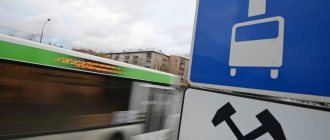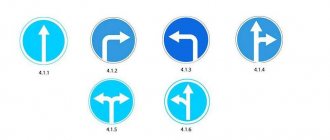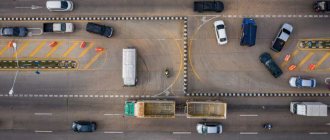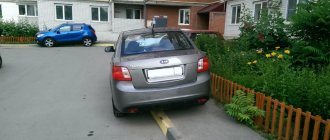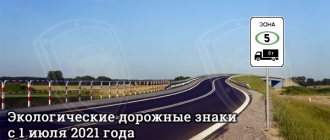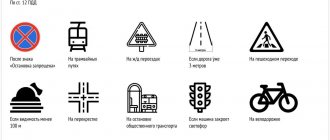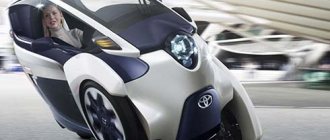There are cases when a driver inadvertently missed a turn and needs to go back. In order not to make a big “detour”, the motorist backs up. Some drivers often drive past empty parking spaces, and then realize that they could have parked in that exact spot. The owner of the car immediately begins to back away in order to have time to occupy a free parking space. Most often, motorists begin to reverse impulsively, without thinking whether such maneuvers are allowed on a given section of the road. It is worth understanding where it is allowed to drive in reverse, and where actions of this kind can lead to a fine. It is important for the driver to be aware of the risks of accidents when driving backwards, and to understand how to avoid collisions.
Where is it prohibited to drive in reverse?
The driver needs to remember that subclause 8.11 of the traffic rules states that you cannot drive in reverse in the following places:
- At controlled and unregulated intersections
- In areas with o
- In the tunnels
- On bridges and overpasses, overpasses and directly under them
- in places where railway crossings are located;
- In places with poor visibility, for example, when the visibility of a section of road in one direction is less than 100 meters;
- At the locations of route vehicle stops.
It is worth paying attention to subclause 16.1 of the traffic rules, which talks about the rules for driving in reverse on the highway. Drivers are prohibited from driving backwards on motorways.
Auto News
- Wide road (3 lanes in each direction).
- The stop is located on the opposite side of the roadway.
- The stop is only indicated by a sign, so it is impossible to clearly define its boundaries.
- The driver turns around not opposite the stop, but at a short distance from the sign.
- When turning, the driver does not touch the outer lane where the stop is located.
In populated areas, public transport stops are quite often designated constructively, i.e. represent a slight widening of the roadway. A wide section of the roadway allows you to make a U-turn without engaging reverse gear. This is what prompts some drivers to turn around at a traffic stop in violation of the rules. Let's consider this issue in more detail.
Penalty for violation
Motorists need to be prepared for fines if:
- if the driver leaves the yard in reverse onto a one-way road, or moves from a two-way road to a one-way road in reverse. Violation results in a fine of 5,000 rubles. Possible punishment in the form of deprivation of the right to drive a vehicle;
- when a motorist drives in reverse from an intersection onto a one-way road, the owner of the car will receive a fine of 500 rubles;
- if in places where reversing is prohibited the driver makes a U-turn, then he will have to pay a fine of 500 rubles;
- if the motorist violated the clause on reversing in prohibited places (bridges, intersections (including roundabouts), railway crossings, tunnels). The fine is 500 rubles;
- reversing on the highway. The fine for maneuvering and driving backwards on the highway will be 2,500 rubles.
Clause 8.11. Traffic rules
The rules say that you cannot turn around:
- directly at pedestrian crossings. The ban on maneuver applies to the section of the road within the width of the crossing, indicated by special markings;
- after entering the tunnel and throughout the entire length of the tunnel.
- on the bridge and under the bridge, regardless of the width of the roadways;
- on overpasses and overpasses;
- At a railway crossing, the ban on turning around applies for the entire length of the crossing; you can turn around only after the barrier installed at the borders. If there is no barrier, then you need to follow the signs.
- if visibility on the road is less than 100 meters in one direction;
- At stops of route transport, you cannot make a U-turn over such a length that the stopping ban applies, in accordance with subclause 12.4 of the Traffic Regulations.
Turning is prohibited, since sections of the road have sufficiently cramped conditions to perform this maneuver, or it is dangerous to turn around in sections, and there is a risk to the life and health of the driver. A car making a U-turn in cramped conditions can become an obstacle for other road users and cause an accident.
A driver who violates the rules faces a fine of 1,500 to 3,000 rubles.
U-turn at a public transport stop
If a stationary car interferes with traffic, and its driver is absent, then the vehicle can be evacuated to a penalty area, in accordance with Part 1 of Art. 27.13 Code of Administrative Offenses of the Russian Federation.
Signs must be double-sided. One-sided signs may be used outside populated areas on sections of roads with a dividing strip where there is no pedestrian traffic along the roads. In populated areas, drivers must give way to trolleybuses and buses starting from the designated stopping place.
Fine for turning around at a public transport stop
There is not enough space for vehicles to turn around in this area; it is very inconvenient to go to the children’s and adult clinics on the street. First, it would be very convenient for local residents living on the street to arrive. Uspensky - residents entering the Fanzavod district are forced to make a circle of more than 10 km every day. The nearest turnaround is only in the area of the Sputnik station.
Due to the lack of this turnaround, the area has become unpresentable and inconvenient for residents due to increased transportation costs. During the modernization of the highway for the APEC Summit in this section, all exits and turnarounds were simply removed without anyone asking whether the local residents needed the turns. At the same time, you give way only to oncoming traffic.
If the road width is small and the driver cannot make a turn from the extreme left position, then the traffic rules (R.8, clause 8.7) provide for a turn from the extreme right position or even from the side of the road. In this case, it is necessary to give way to both passing and oncoming cars. I agree, this is not clear. Perhaps we need to start from where exactly the buses stop.
Normally I would base it on where the bus stop pocket is. But here, well, maybe 5 meters. Of course, the more, the better, but here you can argue with the inspector anyway.
It's time to get acquainted with one more - third and final - version of the horizontal marking in YELLOW. This is marking 1.17, indicating the stopping place for route vehicles and parking for passenger taxis.
In addition, if you violated clause 12.4 of the Russian Federation Traffic Regulations while in a city of federal significance, that is, in Moscow or St. Petersburg, then if a traffic police inspector detects a violation, you will have to pay a fine, which will be slightly higher than in other regions of the country, so, according to Part 6 of Article 12.19 of the Code of Administrative Offenses of the Russian Federation, the amount with which the violator will have to part with will be three thousand rubles.
A U-turn is a maneuver as a result of which a vehicle changes its direction of movement. U-turns on roads can be made at intersections and outside intersections. When turning, you need to clearly see the movement of other cars around and be visible to all road users.
Stopping areas are designed to stop buses moving along established routes in order to disembark and pick up passengers.
You haven't watched the panorama, I hope? There, just in the panorama, there is a lonely pillar with a sign. No markings, not even a pavilion. That is, a meter from this pillar is already possible?
There was no sign 5.15.1, I indicated this in the question. I turned around correctly from the tram tracks as expected, since sign 5.15.1 was missing. The problem is the presence of sign 5.16. The inspector said that I should not turn around in front of this sign.
Moreover, there is a left-most lane. And people, signs, signs! It doesn't say I can't turn around or turn left.
By the way, the length of marking 1.17 is determined by the intensity of traffic of route vehicles and passenger taxis on a given section of the road: the more intense the traffic, the more space is needed to stop and park them and, therefore, the longer the marking. Having engaged the left turn and assessed the safety of the movement, turn the steering wheel to the left and move forward to the opposite curb.
To prove your innocence to a traffic police inspector or to challenge a fine issued, you must know the Russian Federation traffic rules very well, and also understand what constitutes a stop.
Thus, liability under this point will only occur if you do not interfere with the movement of route transport. When observing the “yellow broken line”, the driver must remember the restrictions prescribed by the Traffic Rules.
In addition, clause 9.1 of the traffic rules mentions the drive-in pockets of the stopping places for route vehicles, which gives reason to believe that the length of the entire pocket is the length of the stop for route vehicles, but this is even less obvious.
If you interfere with the movement of public transport by stopping at a bus stop, this will entail a fine.
Road signs in this category are shown on a blue background. You can add the word “only” to any of them. For example, “only straight”, “only left”. Signs 5.16 “Bus and (or) trolleybus stopping place”, 5.17 “Tram stopping place” and 5.18 “Taxi parking place” are used to designate stopping points of the corresponding types of route vehicles and passenger taxi parking.
As can be seen from the figure, the markings we are interested in are applied along the edge of the roadway along the curb or landing area. However, in the case of a tram stop, it can also be found in the middle of the roadway and designate a tram landing area.
Traffic regulations prohibit U-turns “at places where public transport stops.” If this place is indicated by a sign, and not by markings, then what place is considered a “stopping point”: directly around the pavilion? What if there is no pavilion, like in the photo in the topic? The size of the stop, as far as I understand, is not regulated. Then I think for myself that it would be fair to skip the analogy with the clause prohibiting parking at public transport stops: 15 meters from the sign. At least some certainty.
When performing maneuvers, some general rules must be followed. Except in specially specified cases, the driver performing the maneuver must give way to those traffic participants who are not performing maneuvers at the moment. However, in the latter case there is an exception: the driver can stop for the purpose of picking up and unloading a passenger, if in doing so he does not interfere with route vehicles.
Turning around at a public transport stop
Returning to the situation according to clause 8.11, if a passenger car driving along one of the lanes did not have time to react to a truck standing across both lanes (that is, the headlights and dimensions look across the road), did not have time to complete the turning maneuver, and if the passenger car crashes into truck - she will be the culprit of the accident, not the truck. Is this true, or vice versa? Your appeal to the city administration
Vladivostok on the issue of implementing a U-turn on the federal highway A-370 “Ussuri” in the area of st. The first one in Vladivostok was reviewed by the Roads and Improvement Department of the Vladivostok City Administration. In accordance with Part 3 of Article 8 of the Federal Law of 02.05.
2006 No. 59-FZ “On the procedure for considering appeals from citizens of the Russian Federation”, the appeal you sent was forwarded to the Department of Transport and Road Facilities of the Primorsky Territory for consideration on its merits within the time limits established by law. The traffic rules (R.8, clause 8.5) regulate the implementation of a U-turn on the roadway if there are tram tracks on the left.
Therefore, if there are tram rails, then the turn must begin from them, unless, of course, this is prohibited by traffic regulations. Prohibited factors may include markings and road signs. In this case, you need to give way only to oncoming cars and trams.
On an unlit section of a 2-lane road at night with a non-solid dividing line, turning a truck is prohibited. This is a traffic violation. Or not?
Rules for driving in reverse
You can move in reverse provided that the maneuver does not harm other road users and is absolutely safe. The driver must give way to everyone before backing away. If the driver cannot control the situation on the road when moving backwards, the maneuver is prohibited. The rules contain the following points regarding reversing:
- Paragraph 8.12 of the rules talks about places where you cannot back up, and that, if necessary, the driver can resort to the help of other people to safely reverse;
- in subclause 16.1, the traffic rules prohibit reversing on any highways;
- according to subclause 12.16 of the Code of Administrative Offences, you cannot back away and thus drive under a “brick”, otherwise the driver automatically becomes a rule violator and is subject to a fine of 5,000 rubles, or the driver may be deprived of his license for up to 6 months;
- If a driver is driving in reverse and encounters a “no entry” sign in the area adjacent to the road, he may be fined 500 rubles.
Traffic rules for experienced people: how to deal with deprivation of rights
"Gazelle" makes a controversial U-turn on a road with a dividing strip, without leaving the center of the intersection
Artem Krasnov
For beginners behind the wheel, a U-turn is a difficult maneuver, but experienced drivers perform it effortlessly. Despite the apparent simplicity of the maneuver, an unsuccessful turn can provoke a conflict with other drivers and even deprivation of your license. In the “Traffic Rules for Experienced” project, we remember the rules that are forgotten immediately after driving school.
The rules do not stipulate the turning trajectory, so several “schools” have formed among drivers. Many, for example, prefer to stand for a U-turn at the very beginning of the intersection, practically blocking the left lane. Others insist that, as a matter of conscience, the U-turn should be made by driving towards the center of the intersection, but then there is a risk of misunderstanding with the drivers standing behind - they may try to go around on the left.
How to turn around correctly?
If the trajectories intersect, according to paragraph 8.9 of the traffic rules, the one with the obstacle on the right gives way, which means that the driver going to the turn has priority. From an intuitive point of view, this order of passage does not always seem correct, and experienced drivers prefer to give way to those who are too persistently passing them on the left.
Unlike a turn, a U-turn is made from the far left position, even if lane signs allow turning from other lanes. An exception is made for large vehicles that do not have enough space when turning outside the intersection: they can make a maneuver from the right edge or from the right shoulder. But you need to give way to both oncoming and passing people.
There are places where turning around is prohibited: these are tunnels, bridges and similar structures (both above and below them), railway crossings and places with visibility of less than 100 meters. But more often, drivers violate it, forgetting that turning around is prohibited at pedestrian crossings and near public transport stops. Such objects are often located adjacent to an intersection, and a turn along the shortest trajectory passes through them.
Signs can also prohibit turning, for example, “Direction in lanes”, “Traffic straight ahead” and the like
Oleg Kargapolov
A controversial point is making a small-radius turn on roads with a median or tram tracks. At one time, this maneuver caused heated discussions, and the interpretation was different. Inspectors often accused drivers of violating paragraph 8.6 of the traffic rules, which requires turning in such a way as to avoid ending up in the oncoming lane when leaving the intersection.
A turn in this case was represented as two successive turns to the left, and leaving the median strip was a movement along the oncoming lane. The issue was clarified in 2021, when clause 9.1 (1) of the traffic rules appeared. It directly prohibits driving in the oncoming lane separated by tram tracks, a dividing strip or continuous markings. However, in the absence or invisibility of such markings, the issue is still controversial.
In general, drivers are not advised to cut when turning on roads with medians.
By the way, the strip can be not only “physical”, that is, in the form of a lawn, elevation or protective barrier, but also applied using solid marking lines with a distance between them of more than 2 meters.
The left slide shows an intersection where there is a gap between the dividing strip and the roadway being crossed: a U-turn in the yellow zone is allowed (trajectory A). It is also not forbidden to go around a segment of a solid line (trajectory B). On the second slide, trajectory D is prohibited - only option B
Andrey Vinnikov
At the same time, turning around in the spaces of a continuous strip, both outside intersections and directly in front of them, is not prohibited. But only if there are no pedestrian crossings in these gaps.
If there are tram tracks to the left of the driver that are suitable for movement, the turn must be made from them. Exception: continuous markings separating the tracks from the roadway, or the presence of signs “Direction of traffic in lanes” - in the latter case, a turn is made from the leftmost lane.
A turn is considered a rather dangerous maneuver: the driver must let the oncoming traffic pass and turn around so as not to expose himself to it after straightening the trajectory and accelerating. It is acceptable to use small tricks: say, if there is an adjacent area or yard on the left, you can turn there, turn around in a safe place, and only then drive back onto the road.
Is it permissible to turn around in several stages, that is, with reversing?
Outside intersections, let’s say, but not at them, although if the driver doesn’t fit in, he usually has no other options.
Turning across a solid line is a prohibited maneuver. But what is the threat for him? Drivers are sometimes pushed to admit to driving in the oncoming lane, for which they face punishment under Part 4 of Article 12.15 of the Code of Administrative Offences—a fine of 5,000 rubles or deprivation of their license for 4–6 months. In fact, this maneuver is not connected with the movement “against the grain”, and therefore the punishment for it is prescribed under Part 2 of Article 12.16 of the Code of Administrative Offenses - a fine of 1000–1500 rubles.
You need to be careful when turning to the arrow of the additional section. It is likely that cars will turn right from the transverse direction and then it is necessary to give way to them.
In previous episodes of the “Traffic Rules for Experienced” project, we looked at the most “criminal” clause of the traffic rules, and dealt with the rules for driving in yards and on roads with invisible markings.
And at the end we offer you a small test.
Does this combination of signs and traffic lights prohibit U-turns at the intersection?
Source: https://ngs24.ru/news/more/66045361/
Accident while driving backwards
Accidents that occur when reversing are common on Russian roads. The most common situations:
- when one of the road users passes an intersection on the main road and realizes that he has passed the right turn. The driver begins to reverse and crashes into a car that is leaving the adjacent road. Previously, the driver who was driving on a secondary road was considered to be at fault. The 2021 rules say that reversing at intersections is prohibited, and accordingly the motorist who was backing away will be found to be at fault for the accident;
- There are cases when two participants in an accident were moving in reverse. In this case, each of the drivers was not convinced that he was not interfering with others, and began to move backwards. When an accident occurs in a parking lot, both participants in the accident are found guilty, since they did not take care of the safety of the maneuver;
- traffic police inspectors going to the scene of accidents often identify the culprit in accordance with subclause 8.9 of the traffic rules, when the driver must give way to obstacles on the right, i.e. all vehicles driving on the right side (the side is determined relative to the motorist whose gaze is directed forward).
Accidents often occur when parallel parking, for example, if the driver does not know how to use the rear-view mirrors. Some newcomers to the road look at only one right one instead of all three mirrors, and when parking, the car ends up “rubbing in” with another stationary vehicle.
There are motorists who see that a driver parking in reverse poses a real threat to them, and, frightened by an emergency situation, they try to move just at the moment when the parking driver crashes into them.
U-turn at a public transport stop – PravoSistema
Every driver is constantly faced with a situation where he needs to turn around.
Of course, the reasons are different for everyone - someone understands that they made a mistake with the choice of route and wants to go back, while another motorist simply cannot get to the right place without using a U-turn.
Let's talk about how you should behave in order to carry out the maneuver as safely as possible and not receive a fine from the traffic police officer.
Dear reader! The article describes the most common legal problems and ways to solve them. If you want to find out how to solve your particular problem, contact a consultant for free help:
Moscow, Moscow region: +7 (499) 288-72-46
St. Petersburg, Leningrad region: +7 (812) 317-60-18
Regions, Federal number: +8 ext. 859
24/7, FREE, FAST
How to turn around correctly - execution technique
Experienced drivers usually perform a U-turn almost automatically, sometimes without even thinking about the sequence of actions. However, beginners care about everything: choosing a place, speed, position in the lane, road signs and markings, that is, the algorithm as a whole. If we talk about the technique of making a U-turn, then motorists should consider the following points:
- Make sure that turning around in the chosen place does not contradict the rules of the road.
- It is important to adequately assess the situation, so it is assumed that the driver needs to clearly see the road at least 100 meters forward and backward. Near the section of the roadway where you decide to turn around, there should be no turns, kinks or anything else that could prevent you from viewing the road in both directions.
- When you are about to turn around, do not forget to notify other road users about this - turn on the left turn signal.
- If you are going to make a U-turn at an intersection, you need to take the extreme left position, and do it in advance, and not at the last moment.
- If you plan to turn around outside a road intersection, the maneuver can be carried out in several steps, depending on the situation.
- Look in the mirrors - it’s better to make sure once again that you are not interfering with other vehicles, and other cars are not interfering with you. Give way to oncoming traffic. Slow down, take your time.
- During the actual turn, the main thing will be correct control of the car - quickly but smoothly rotate the steering wheel using the interception method. Many beginners frantically finger the steering wheel, not knowing which place to grab, and simply do not have time to turn it in time. Remember that when turning, the right hand starts the rotation, and the left one helps.
- As soon as you turn around, straighten the steering wheel, gradually increase speed and turn off the left turn signal.
- Some people believe that when turning at an intersection, it is enough to change lanes to the left before the maneuver and drive in its center, but this is not at all true - even in the lane you must move as far as possible to the left, only from this position can you turn around according to traffic regulations.
How to prevent road accidents?
Often, a motorist driving in reverse becomes the culprit of an accident. The driver, while moving backwards, must yield to all road users, and any emergency situation will be his fault. Subclause 8.12 transfers full responsibility for incidents to motorists, and does not make allowances even for poor visibility if potentially dangerous moments could have been predicted.
To avoid accidents you must:
- Before performing a maneuver, monitor the situation on the road; if in doubt, it is better to get out of the car and assess what is happening around.
- If you need help and an outside perspective, it is better to ask a passerby to act as a navigator;
- It is important to take your time and back up slowly so that you can always have time to brake;
- beginners need to remember to look in the mirrors when driving backwards; you can turn back and look out the rear window;
- If the driver sees a vehicle moving backwards approaching him, then he should not engage reverse, it is better to attract attention with a sound signal. An experienced motorist will hear the sound and stop driving;
- If, while driving in reverse, the driver hears a sharp signal, then you need to immediately stop and look around what is happening around. Perhaps braking will help avoid an accident;
- always look in the rearview mirrors;
- When a motorist moves between rows in a parking lot, it is necessary to monitor the cars that are on the left and right sides.
There are drivers who ignore or do not hear sound signals. It is worth considering such points, and if after the signal the car continues to move in reverse, then it is better to carefully drive away from such a vehicle. It is important to remember that you only need to drive away in forward gear, otherwise there is a risk of creating an emergency situation yourself.

